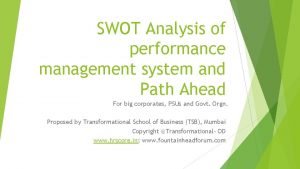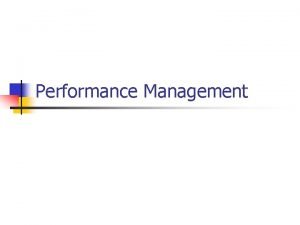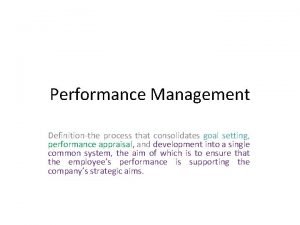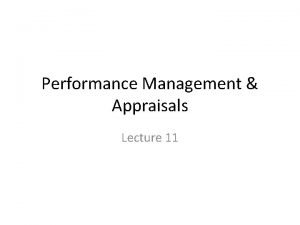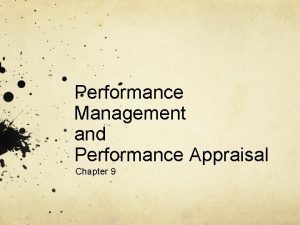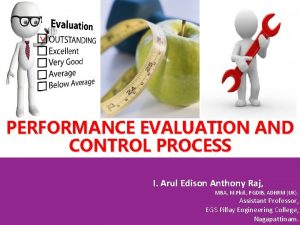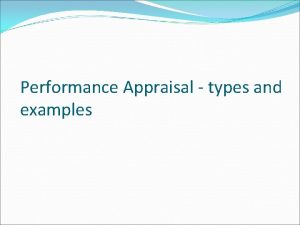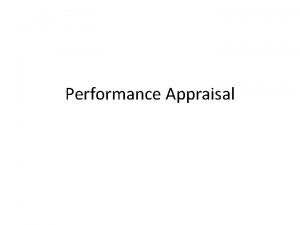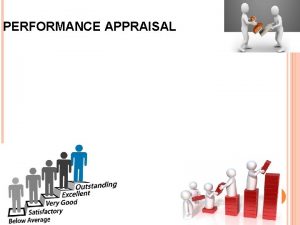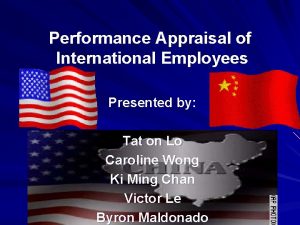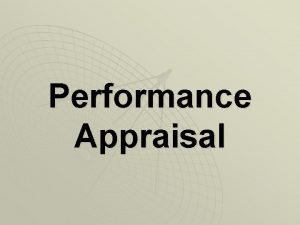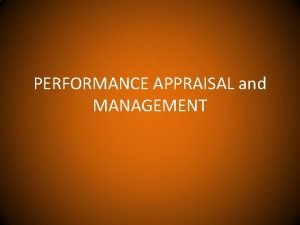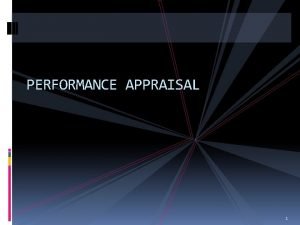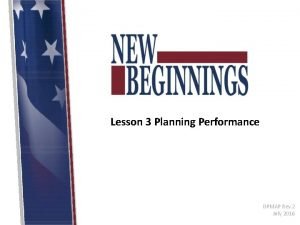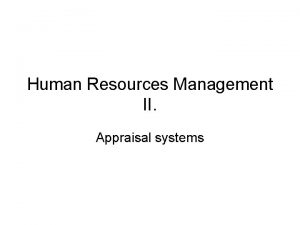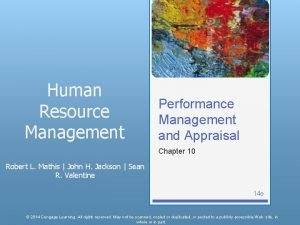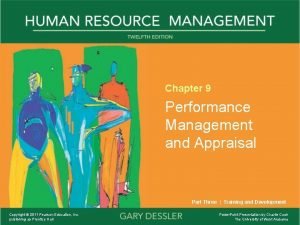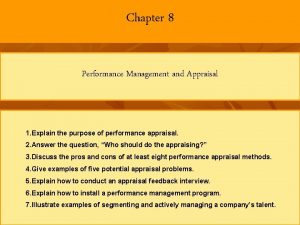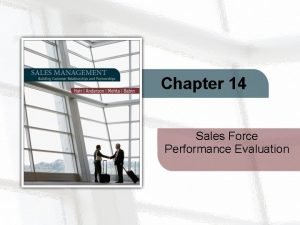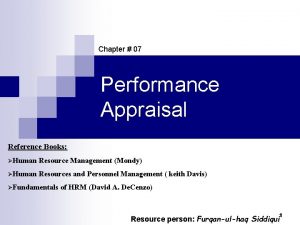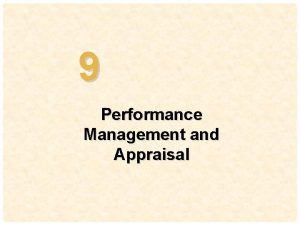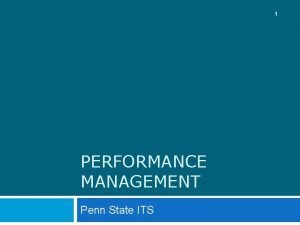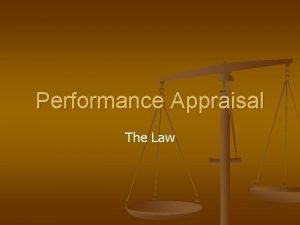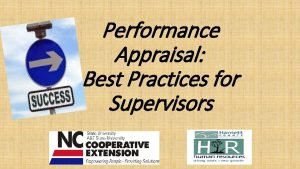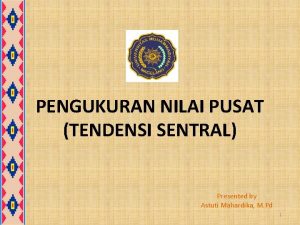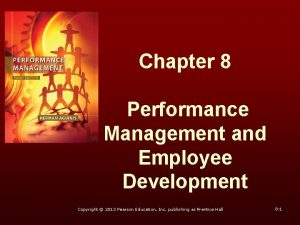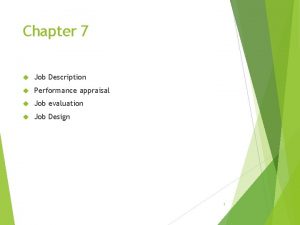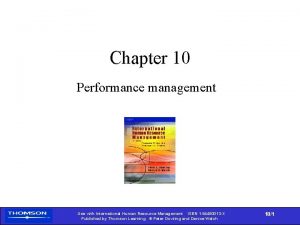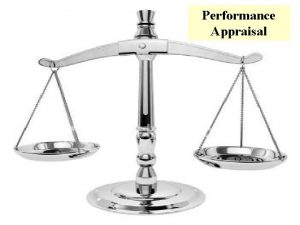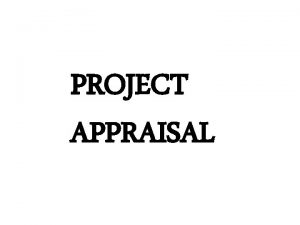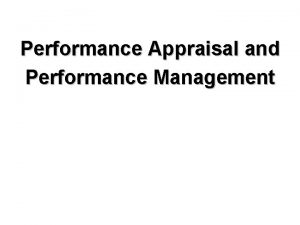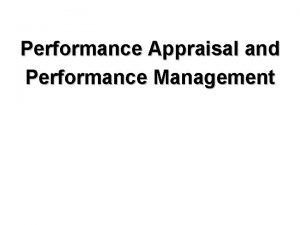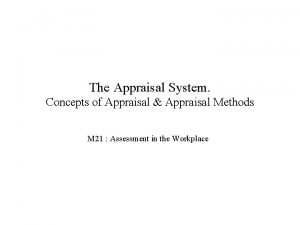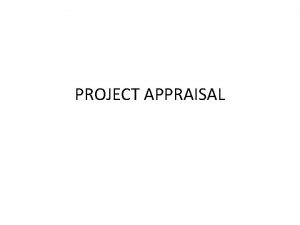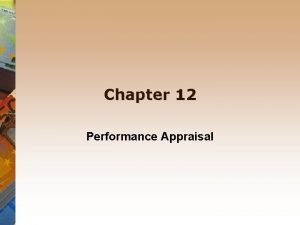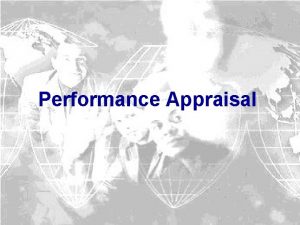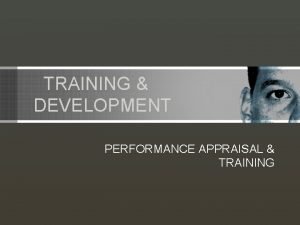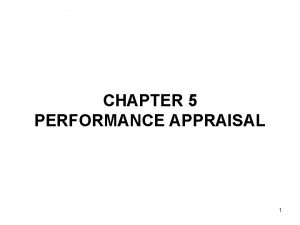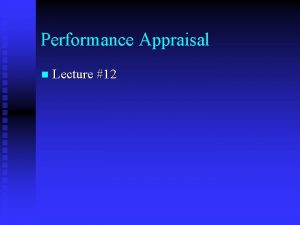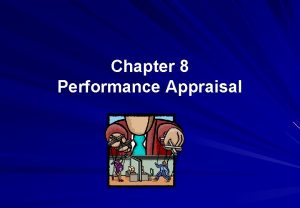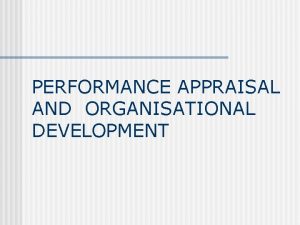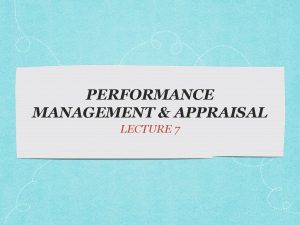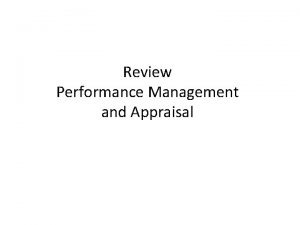PERFORMANCE APPRAISAL MEANING OF PERFORMANCE APPRAISAL According to

































- Slides: 33

PERFORMANCE APPRAISAL

MEANING OF PERFORMANCE APPRAISAL “According to Edward Flippo, PERFORMANCE APPRAISAL is the systematic, periodic and an imparting rating of an employee’s excellence in matters pertaining to his present job and his potential for a job. ”

FEATURES OF PERFORMANCE APPRAISAL Systematic process of evaluation of an employee. Analysis of the strengths and weaknesses of an employee. To find out how well an employee is performing the job. Appraisal is done periodically. The appraisal is an ongoing and continuous process.

OBJECTIVES OF PERFORMANCE APPRAISAL To provide employees feedback on their performance. Identify employee training needs. To improve efficiency. A basis for decisions relating to salary increases, promotions, bonuses etc. To Provide the opportunity for growth and development. To provide counselling and motivation to employees. To develop positive superior – subordinate relationship.

BENEFITS AND USES OF PERFORMANCE APPRAISAL

LIMITATIONS OF PERFORMANCE APPRAISAL Halo error and Horn effect. Central tendency. strictness/leniency. Similarity error. Miscellaneous biases. Spill over effect. Fear of spoiling relations. Discouragement.

PERFORMANCE APPRAISAL PROCESS

ESSENTIALS OF EFFECTIVE APPRAISAL SYSTEM Mutual trust and confidence. Training to appraisers. Feedback. Less time consuming and economical. Open communication. Post appraisal interview.

MADE BY - BHAKTI ROLL NO. - 177 CLASS - BCOM 1 A

TRADITIONAL METHODS Akshita Roll no- 167

CONFIDENTIAL REPORT • Prepared by immediate supervisor of the employees • Descriptive report • The report highlights the strengths and weaknesses of employees • Prepared in Government organizations • Does not offer any feedback to the employee

GRAPHICAL SCALE METHOD • Simplest and most popular method • Rating scale lists traits and performance value for each trait • Factors studied : 1. Characteristics 2. Contribution • Continuous and discontinuous

STRAIGHT RANKING METHOD • Simplest and old merit-rating method • Single rating group for all employees • We can only say who is number 1, 2, 3 and so on but cannot say how much the person at number 1 is better than number 2 • Suitable only in case limited persons

PAIRED COMPARISON METHOD • Employees are compared in pairs • More reliable than straight ranking • Suitable only in small organisations

GRADING SYSTEM • Grades are assigned- A, B, C, D, E…. • Grades given according to the judgement of the rater • A- outstanding • B- very good • C- good • D- average • E- below average A B C

FORCED DISTRIBUTION METHOD • All the employees are divided into five categories: 1. Outstanding 10% 2. Above Average 20% 3. Average 40% 4. Below Average 20% 5. Poor 10% • Avoids similar training of employees • Minimises rater’s bias § Rater does not explain the reason of placing an employee in a particular category § No specific criteria followed while calculating

CHECKLIST METHOD • Consists of statements that describe the performance and characteristics of employees on the job • Rate indicates whether the employee behaviour is positive or negative • Employees rated on the basis of number of positive checks • Three types of checklists: 1. Simple Check List 2. Weighed Check List 3. Forced Check List

CRITICAL INCIDENT METHOD • Measures performance in terms of certain events that occur in the course of the job • Critical events determine employee’s failure or success • For this supervisor keeps a record of critical situations • Objective ranking • Chances of employee improvement § Critical incidents may not happen regularly § Difficult to describe whether an incident is critical or not

FREE ESSAY METHOD • Supervisor writes a report about the employee • Report in form of essay based on his performance • Provides specific information § Non quantitative technique § Biasness because of liking or disliking of the supervisor § Time factor

GROUP APPRAISAL • Employees are rated by an appraisal groups • This group consists of supervisor and other specialised persons • Group discuses about the performance of the employee and reasons for such performance • Devoid of personal bias • Simple method § Time consuming

FIELD REVIEW METHOD • The appraiser goes to the field and obtains the information about work performance of the employee by way of questioning the said individual, his peer group, and his superiors • There is overall rating • Success of this method depends upon competence of interviewer

MORDERN METHODS OF PERFORMANCE APPRAISAL BY: DIVYANI BHUSHAN ROLL NO: 145 B. COM 1

MORDERN METHODS OF PERFORMANCE APPRAISAL ASSESSMENT CENTER HUMAN RESOURCE ACCOUNTING 720 DEGREE APPRAISAL MANAGEMENT BY OBJECTIVE BEHAVIOURAL ANCHORED RATING SCALE COMPUTERIZED AND WEB BASED CUSTOMER FEEDBACK 360 PERFORMANCE APPRAISAL

ASSESSMENT CENTER q IT IS A PLACE TO EVALUATE AN INDIVIDUAL POTENTIAL AND PERFORMANCE TO POSITION HIM/HER IN KEY FUNCTIONAL AREAS. q AN ASSESMENT CENTER TYPICALLY INVOLVES: § SOCIAL EVENTS § TESTS § EXERCISE § ASSIGNMENT

HUMAN RESOURCE ACCOUNTING • MEASURE EFFECTIVENESS OF PERSONNEL MANAGEMENT ACTIVITIES. • IT IS THE PROCESS OF ASSIGNING , BUDGETING AND REPORTING THE COST OF HUMAN RESOURCE IN THE ORGANISATION.

BEHAVIOURAL ANCHORED RATING SCALE ü IT COMBINES THE BENEFITS OFCRITICAL INCIDENTS AND GRAPHIC RATING SCALES BY ANCHORING A SCALEWITH SPECIFIC BEHAVIOURAL EXAMPLE STEPS a) GENERATE CRITICAL INCIDENTS. b) DEVELOP PERFORMANCE DIMENSIONS. c) REALLOCATE INCIDENTS. d) SCALE THE INCIDENT. e) DEVELOP FINALINSTRUMENT.

MANAGEMENT BY OBJECTIVE • IT IS THE PROCESS WHERE SUPERIOR AND SUBORDINATES MANAGERS OF AN ORGANISATION JOINTLY DEFINES ITS GOALS AND INDIVIDUAL AREA OF RESPONSIBILITIES.

360 DEGREE APPRAISAL • IT IS THE SYSTEMATIC COLLECTION OF PERFORMANCE DATA ON AN INDIVIDUAL GROUP DERIVED FROM A NUMBER OF STAKE HOLDERS.

720 DEGREE APPRAISAL • SIMILAR TO 360 DEGREE METHOD BUT INFORMATION ABOUT THE GROUP IS ALSO COLLECTED FROM OUTSIDE THE ORGANISATION SUCH AS CUSTOMERS SUPPLIERS INVESTORS. • It HAS 8 DIMENSIONS: 1. Self 3. Suppliers. 5. Subordinates 2. Peer 4. Customers. 6. Superior 7. Family 8. Shareholder.

CUSTOMER FEEDBACK METHOD • ESPECIALLY USED FOR SALES STAFF IN WHICH CUSTOMER FEEDBACK IS DIRECTLY LINKED WITH EMPLOYEE PERFORMANCE.

POTENTIAL APPRAISAL IT IS THE IDENTIFICATION OF HIDDEN TALENTS AND SKILLS OF A PERSON. IT IS FUTURE ORIENTED APPROACH.

PURPOSES v Inform employees about there future prospectus. v Helpful to draft a future succession. v To update training and recruitment activities. v To enhance career opportunities for employees. TECHNIQUES Ø Self appraisal. Ø peer appraisal. ØSuperior appraisal. Ø MBO Ø Management games. Ø Leadership exercises. BASIS POTENTIAL PERFORMANCE NATURE FORWARD LOOKING BACKWARD LOOKING RELIABILITY LESS MORE ADVANTAGE MORE TO EMPLOYEES MORE TO ORGANISATION

PERFORMANCE APPRAISAL AT PEPSI-COLA INTERNATIONAL • OPERATES IN OVER 150 COUNTRIES. • ADMINISTRATIVE EFFICIENCY IS ACHIEVED THROUGH PERFORMANCE APPRAISAL SYSTEM OF FIVE FEEDBACKS 1. INSTANT FEEDBACK. 2. COACHING 3. ACCOUNTABILITY 4. DEVELOPMENT 5. HUMAN RESOURCE PLANNING
 Bars performance appraisal
Bars performance appraisal Behaviorally anchored rating scales
Behaviorally anchored rating scales Traditional method of performance appraisal
Traditional method of performance appraisal Swot analysis of performance management system
Swot analysis of performance management system Objectives of performance review counselling
Objectives of performance review counselling Combine absolute and relative standards
Combine absolute and relative standards Checklist method
Checklist method Unclear standards in performance appraisal
Unclear standards in performance appraisal Purpose of appraisal
Purpose of appraisal Graphic rating scale example
Graphic rating scale example Selection validation in performance appraisal
Selection validation in performance appraisal Perfomance appraisal
Perfomance appraisal Tat in appraisal comments
Tat in appraisal comments Meaningu
Meaningu Past oriented appraisal methods
Past oriented appraisal methods Joseph tiffin
Joseph tiffin Dpmap performance elements and standards examples
Dpmap performance elements and standards examples Types of appraisal methods in hrm
Types of appraisal methods in hrm Performance appraisal in human resource management
Performance appraisal in human resource management Human resource management fifteenth edition
Human resource management fifteenth edition Government performance appraisal examples
Government performance appraisal examples Behaviorally anchored rating scale
Behaviorally anchored rating scale Chapter 8 performance management and appraisal
Chapter 8 performance management and appraisal Sales performance appraisal
Sales performance appraisal References of performance appraisal
References of performance appraisal Paired comparison method of performance appraisal
Paired comparison method of performance appraisal Penn performance appraisal
Penn performance appraisal Legal issues in performance appraisal
Legal issues in performance appraisal Appraisal best practices
Appraisal best practices Pengukuran tendensi sentral
Pengukuran tendensi sentral Seafarer performance appraisal
Seafarer performance appraisal Performance management and appraisal chapter 8
Performance management and appraisal chapter 8 Performance appraisal job description
Performance appraisal job description Expatriate performance appraisal
Expatriate performance appraisal



